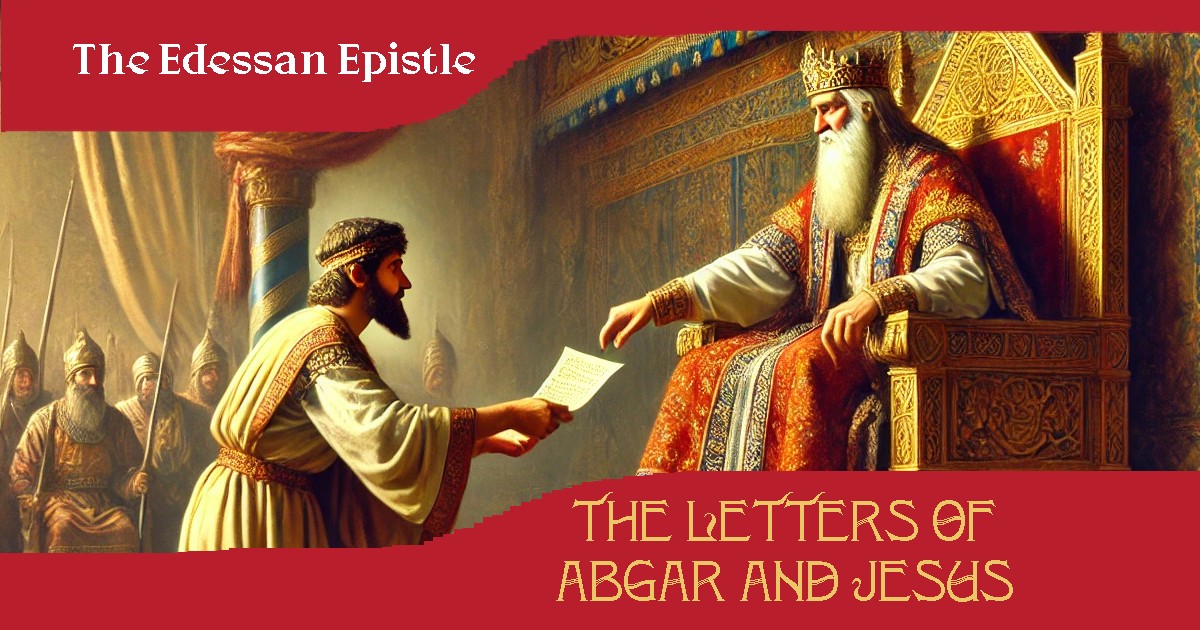The Discovery of the Letters
In the early 4th century, the historian Eusebius of Caesarea made a startling claim. While researching the archives of the city of Edessa (modern-day Şanlıurfa, Turkey), he discovered an astonishing document: a written exchange between King Abgar V of Edessa and Jesus of Nazareth.
According to Eusebius, this letter had been carefully preserved in Edessa’s royal records, written in Syriac Aramaic and later translated into Greek. The correspondence consisted of two letters:
- King Abgar’s Letter to Jesus – In this document, the king, suffering from a terrible illness (often described as leprosy), acknowledges Jesus’ divine powers and asks him to come to Edessa to heal him. He even offers Jesus refuge from the hostile authorities in Judea.
- Jesus’ Reply – Jesus, in a remarkably rare written response, praises the king’s faith but declines the invitation. Instead, he promises that after his ascension, he will send one of his disciples to heal Abgar.
The Story That Followed
After Jesus’ resurrection and ascension, the legend continues: Thaddeus (Addai), one of the seventy disciples, eventually traveled to Edessa and fulfilled Jesus’ promise by healing Abgar and converting the city to Christianity.
This story became central to Edessa’s Christian identity. The city claimed to be the first Christian kingdom, blessed directly by Jesus himself. The letters were revered as holy relics and played a crucial role in Edessa’s claim to divine legitimacy.
The Problem with the Letters
While this legend spread throughout early Christianity, modern historians and textual critics have a different take.
Eusebius Is the First to Mention Them
If the letters were genuine, why didn’t earlier Christian writers—such as Paul, Irenaeus, or Origen—mention them? The earliest reference to these letters comes from Eusebius (c. 325 CE), nearly 300 years after Jesus supposedly wrote them. That’s a huge red flag.
a Political Purpose
The idea that Jesus personally corresponded with a foreign king serves a clear political and religious agenda. By claiming to have a direct connection to Jesus, Edessa established itself as a holy city and strengthened its Christian identity.
Jesus Stories in Early Christianity
The story of King Abgar’s letter fits into a broader pattern found in early Christian literature: the tendency to insert Jesus into new narratives to serve theological, political, or evangelistic purposes.
The Trend of Jesus Stories
Long after Jesus was first introduced in letters and a gospel, Christian writers kept finding ways to make him part of new and evolving narratives.
- The Infancy Gospels – Later Christians, unsatisfied with the lack of details about Jesus’ childhood, wrote entire books (such as the Infancy Gospel of Thomas) where a young Jesus performs miracles, scolds teachers, and even curses a boy to death before bringing him back to life.
- The Gospel of Nicodemus – A later work that expands on Jesus’ trial and descent into Hell, adding dramatic courtroom scenes and conversations between Jesus and Pontius Pilate.
- The Acts of the Apostles (Apocryphal) – Various later “Acts” books (such as The Acts of Paul and Thecla) feature Jesus appearing in visions or messages to guide later followers.
In each case, Jesus is written into new contexts, shaping the faith in ways that reflect the needs and interests of different Christian communities.
The Political Use of Jesus
The Abgar letters fit neatly into the political needs of early Christian communities. By having Jesus personally correspond with a foreign king, Edessa could claim divine legitimacy. This wasn’t unique—other regions and rulers sought to do the same:
- Constantine’s Vision – The Roman Emperor Constantine later claimed he had a vision of Jesus before his victory at the Battle of the Milvian Bridge (312 CE). This story helped solidify Christianity’s place in the empire.
- Jesus and Rome – Various early Christian texts worked to retrofit Jesus into Roman history, often portraying Roman figures as either recognizing or opposing his divine authority.
- Jesus in Britain? – In later medieval legends, some even claimed Jesus visited Britain as a child with Joseph of Arimathea, a clear attempt to Christianize distant lands.
The idea of Jesus sending a letter to a king follows the same pattern—it elevates Christianity’s status by associating it with political power.
Christianity’s Evolving Mythos
The fact that the Abgar story emerged centuries after the original distribution of the gospel tells us something important: early Christians weren’t afraid to modify or expand their history with their own revelations. Stories were reshaped, added, and forged to reinforce the faith.
- Authority Through Fabrication – Writing Jesus into a story was a way of granting it authority. If Jesus endorsed a city, a ruler, or a doctrine, it carried divine weight.
- Legitimizing New Christian Centers – Just as Rome would later claim authority through Peter and Paul, Edessa’s claim to a personal connection with Jesus strengthened its religious standing.
Common Patterns in Early Christianity
The letters between Jesus and King Abgar are likely not authentic, but they fit perfectly into the broader trend of writing Jesus into history. Whether it was childhood miracle stories, secret teachings, or royal endorsements, early Christians weren’t just preserving Jesus’ words—they were expanding his influence into new realms. The Abgar legend is just one example of how Jesus continued to be “written into the story” long after his time on Earth.
References
- Eusebius of Caesarea, Ecclesiastical History, Book I, Chapter 13
- Bart D. Ehrman, Forged: Writing in the Name of God—Why the Bible’s Authors Are Not Who We Think They Are
- Richard Carrier, On the Historicity of Jesus
- Walter Bauer, Orthodoxy and Heresy in Earliest Christianity
- Sebastian Brock, The History of the Holy Edessa

